Brain Scans May Lead to Early Intervention For Dyslexia

MRI image via Shutterstock
When children are diagnosed with dyslexia, it’s often because their teachers notice that they are struggling in school. But a new research project from MIT and Boston Children’s Hospital could change that by identifying dyslexia in children through the use of brain scans before they even start school.
Kelli Sandman-Hurley, the co-director of the Dyslexia Training Institute in San Diego says that the new technology would change the entire landscape of dyslexia treatment and diagnosis. Approximately one in 10 Americans suffer from the condition. “Identifying dyslexia in children before they fail in school would mean that they could get interventional therapy when they need it most, before school becomes miserable for them,” she says. Sandman-Hurley also notes that the use of brain scans would eliminate the guessing game that currently occurs when teachers try to help students who struggle with reading.
In a recent paper describing the research, which was published in the August 14 issue of the Journal of Neuroscience, the study’s authors related the connectional fibers of the brain with phonological awareness in children who couldn’t read yet. Phonological awareness measures a child’s awareness of the sound structures of spoken words, and is an indicator of dyslexia. Zeynep Saygin, a post-doc researcher at MIT and a member of the team conducting the study, explains that previous studies had shown that the white matter tracts in the brain were less organized in adults with poor phonological awareness and dyslexia. Because of this, her team decided to study children in hopes that brain structure and organization would lead to earlier identification of dyslexia.
The team invited 40 kindergarteners to come to Boston Children’s Hospital. Through MRIs, the researchers were able to look at the size and organization of the white matter tracts in the brains of the children. What they found confirmed and extended previous research in adults: children with lower phonological awareness had less developed white matter tracts in the areas of the brain that connected language-processing centers. The researchers could structurally see whether or not a child struggled with phonological awareness and might develop dyslexia.
What’s next? Saygin and her team hope to follow up with the kindergarteners when they are in second grade to confirm that less developed white matter tracts really do predict dyslexia. She hopes that the research will lead to aggressive early interventions and less anxiety for children who struggle in school. “This study demonstrates how we can use neuroscience to better inform parents, researchers, and educators about what is going on in the brain when it comes to poor reading and dyslexia,” Saygin says.


